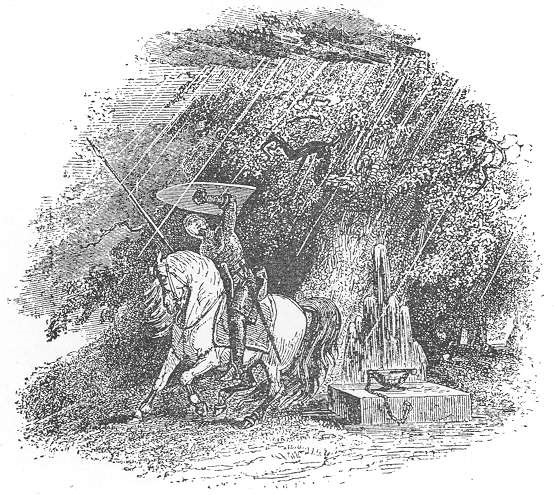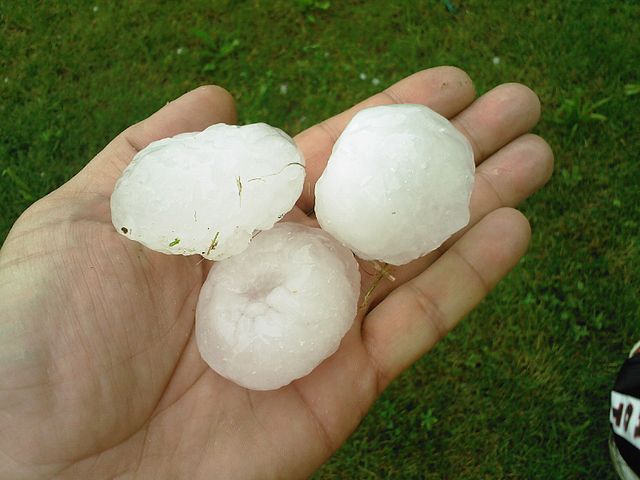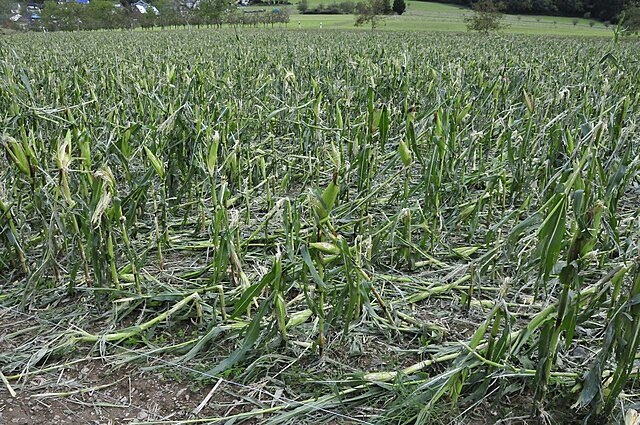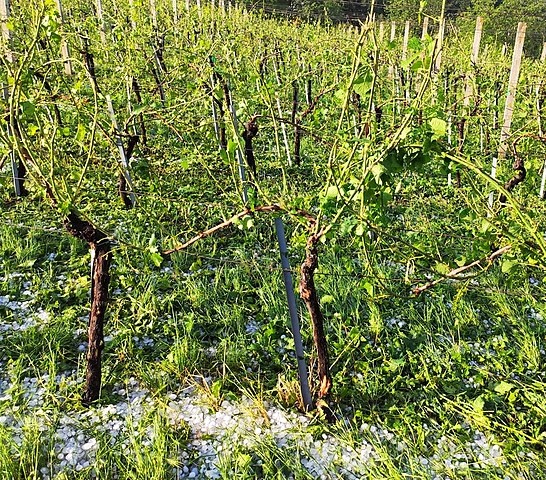Hail (5e Hazard)
Hail[edit]

Hail is formed during thunderstorms when updrafts within the storms repeatedly lift water droplets to high altitude, where they freeze at very low temperatures, and then eventually fall back to the ground as Hailstones. Most Hailstorms occur in plains terrain, in the spring and early summer, and in the late afternoon or early evening. Falling hailstones can be very dangerous and cause significant destruction to crops, forests and buildings. In terms of size, hailstones range between 0.2 inch (5 mm) and 6 inches (15 cm) in diameter. Large hailstones can weigh more than 1.1 lb (0.5 kg). Hailstones 1-2 inches in diameter may fall at speeds of 25-40 mph, while larger hailstones 2-4 inches in diameter may fall at 44-72 mph. The largest hailstones (more than 4 inches in diameter) may fall at speeds of 100 mph. Hail can fall up to 2 miles (3.7 km) away from the parent storm. Swaths of fallen hail from a single storm can range in size from a few acres to an area 10 miles wide and 100 miles long.
OMEN/SIGN: You notice a large thunderstorm approaching, and the lower clouds are an eerie shade of green. (Druids and Rangers may make a DC 8 Intelligence (Nature) check to recognize that such a storm has a high chance of producing dangerous hail.)

EFFECTS: Because Hailstones can be large, heavy, and fall at high speeds, they can cause injury and significant destruction. However, larger, more damaging Hailstones occur less frequently. When Hail is encountered, roll 1d20 on the table below to determine the Hailstone size and damage effects.
HAIL DAMAGE TABLE
| d20 | Hailstone Size | Hailstone Description | Cumulative Damage Effects |
|---|---|---|---|
| 1-6 | up to 0.75 inch | Smaller than a penny | 25% crops destroyed |
| 7-10 | 0.75 inch | Penny | 50% crops destroyed |
| 11-13 | 1.00 inch | Quarter | 75% crops destroyed, glass windows broken, paint/wood scarred |
| 14-15 | 1.50 inches | Ping-pong Ball | All crops destroyed, thatched roofs damaged, 1d4 damage to unsheltered creatures |
| 16-17 | 1.75 inches | Golf Ball | All crops destroyed, tiled roofs damaged, 1d6 damage to unsheltered creatures |
| 18 | 2 inches | Egg | All crops destroyed, wagons/cart damaged, 1d8 damage to unsheltered creatures |
| 19 | 2.5 inches | Tennis Ball | All crops destroyed, wooden roofs damaged, 1d12 damage to unsheltered creatures |
| 20 | 3.5+ inches | Softball | All crops destroyed, fields salted, most roofs destroyed, 1d20 damage to unsheltered creatures |


OPTIONAL EFFECTS: After falling, hailstones might make the ground slippery, perhaps DC 10 Dex save or fall prone. If a hailstorm occurs while players are in a forest, replace direct damage from hail with direct damage from falling, splintered, tree limbs (perhaps 1d6 piercing damage). A hailstorm at sea could shred sails, leaving a sailing vessel adrift.
DM TIPS: Hailstorms are a great alternative to tornados as a natural hazard in plains/steppe terrain. A hailstorm during combat adds an exciting complication to the encounter. After falling, hailstones make the ground slippery and can be thrown as rocks. If direct injury to PCs does not fit the situation, hailstones might instead injure horses, pets/familiars, etc., or destroy a random item of gear, a helmet, a shield, a cart, wagon, etc. As a plot twist, a hailstorm (or sleet storm) might counteract a wildfire (on plains or in a forest) that is about to harm the PCs.
NOTE 1: Sleet is another form of frozen precipitation, but sleet "stones" are typically about the size of a pea, much smaller than hailstones. Sleet is caused by a temperature inversion--a layer of warm air sandwiched between two layers of cold air--that causes snow to melt and then refreeze as it descends. Sleet is too small to cause direct damage to PCs.
NOTE 2: Freezing rain is yet another form of frozen precipitation that occurs when snowflakes descend into a warmer layer of air and melt completely before reaching frozen ground. Upon contact with frozen ground, a layer of Glaze is typically formed. Glaze is a smooth coating of ice on the ground and on objects such as trees, roads and rooftops. An accumulation of Glaze is heavy and can cause tree limbs and even roofs to break. A period of freezing rain that lasts several hours or more is called an Ice Storm.
SOURCES: (See Talk/Discussion page.)
Back to Main Page → 5e Homebrew → Hazards

